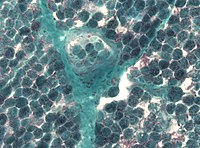
Photo from wikipedia
We appreciate the letter in response to our article [1]. Our report revealed that chemical exchange saturation transfer (CEST) and magnetic resonance spectroscopy (MRS) using 7T magnetic resonance imaging (MRI)… Click to show full abstract
We appreciate the letter in response to our article [1]. Our report revealed that chemical exchange saturation transfer (CEST) and magnetic resonance spectroscopy (MRS) using 7T magnetic resonance imaging (MRI) could detect lactate level elevation prior to the formation of cerebral morphological abnormalities in Ndufs4 knockout (KO) mice, a mouse model of Leigh syndrome [1]. The letter claimed that Ndufs4 KO mice investigated in the present study do not represent an animal model of Leigh syndrome. We performed MRI and CEST in the mice when they were 6 weeks of age. They did not show any lesions in T2-weighted MRI (T2WI), but at around 8 weeks of age they manifested Leigh syndrome features with 100% penetrance. Ndufs4 KO mice that we used in this study were produced and well established as a model of Leigh syndrome by the Palmiter Laboratory at the University of Washington [2, 3]. A model of Leigh syndrome is characterized by failure to thrive, generalized hypotonia, developmental delay, central respiratory compromise, ataxia, and epilepsy [4], as well as bilateral and symmetrical necrotic lesions in the basal ganglia and brainstem, which appear as hyperintense lesions on T2WI [5]. All the features were reproduced in the environment in our animal facility. Therefore, we conclude that Ndufs4 KO mice are an appropriate animal model of Leigh syndrome. The point we claim is that the increase in cerebral lactate level on MRS reflects an early stage of the disease before morphological abnormalities are detectable on T2WI. Actually, in our previous study, we performed serial measurement of brain MRI and MRS. Brain MRS was performed in the Ndufs4 KO mice and control mice at age 5–9 weeks using 7T MRI. In KO mice that survived until 9 weeks of age, both MRS and T2WI were longitudinally performed in the same individuals at 5, 7, and 9 weeks. Brain MRS demonstrated increased lactate levels in KO mice than in control mice. The increased intracerebral lactate levels could be observed at 5 weeks of age, whereas no obvious abnormal findings were detected in T2WI (Fig. 1a). Longitudinal MRS experiments revealed a temporal increase of intracerebral lactate levels, which peaked at week 7, followed by a decrease at week 9. During this period, further disease progression with brain lesions was detected on T2WI [5]. Serial T2WI of the brain revealed no abnormal lesions in KO mice at 5 weeks of age (Fig. 1a). However, at 9 weeks of age, bilateral and symmetrical lesions were detected in the postlateral portion of the brainstem in the KO mice only. Our non-invasive imaging of cerebral lactate using CEST and MRS is useful for diagnosing some of mitochondrial disorders; however, there are mitochondrial This reply refers to the article available at https ://doi.org/10.1007/ s1219 4-019-00511 -z.
Journal Title: Radiological Physics and Technology
Year Published: 2019
Link to full text (if available)
Share on Social Media: Sign Up to like & get
recommendations!